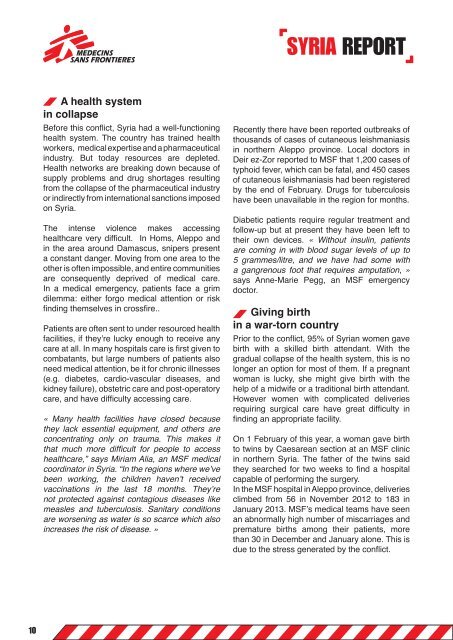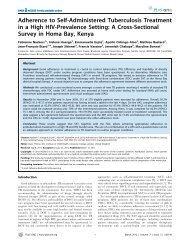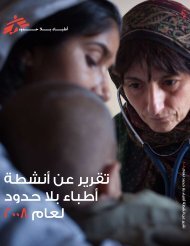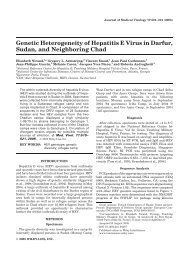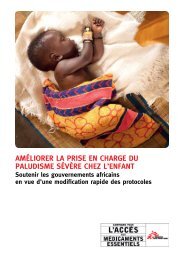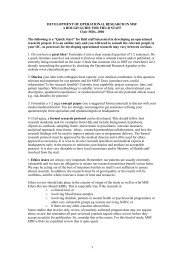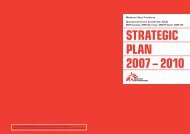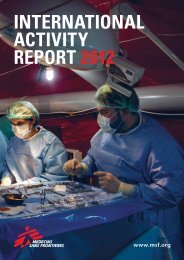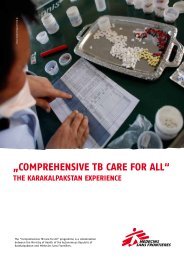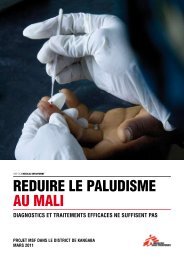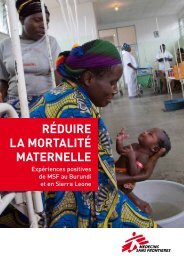Syria Two Years On (PDF)
Syria Two Years On (PDF)
Syria Two Years On (PDF)
- No tags were found...
Create successful ePaper yourself
Turn your PDF publications into a flip-book with our unique Google optimized e-Paper software.
<strong>Syria</strong> reportA health systemin collapseBefore this conflict, <strong>Syria</strong> had a well-functioninghealth system. The country has trained healthworkers, medical expertise and a pharmaceuticalindustry. But today resources are depleted.Health networks are breaking down because ofsupply problems and drug shortages resultingfrom the collapse of the pharmaceutical industryor indirectly from international sanctions imposedon <strong>Syria</strong>.The intense violence makes accessinghealthcare very difficult. In Homs, Aleppo andin the area around Damascus, snipers presenta constant danger. Moving from one area to theother is often impossible, and entire communitiesare consequently deprived of medical care.In a medical emergency, patients face a grimdilemma: either forgo medical attention or riskfinding themselves in crossfire..Patients are often sent to under resourced healthfacilities, if they’re lucky enough to receive anycare at all. In many hospitals care is first given tocombatants, but large numbers of patients alsoneed medical attention, be it for chronic illnesses(e.g. diabetes, cardio-vascular diseases, andkidney failure), obstetric care and post-operatorycare, and have difficulty accessing care.« Many health facilities have closed becausethey lack essential equipment, and others areconcentrating only on trauma. This makes itthat much more difficult for people to accesshealthcare,” says Miriam Alia, an MSF medicalcoordinator in <strong>Syria</strong>. “In the regions where we’vebeen working, the children haven’t receivedvaccinations in the last 18 months. They’renot protected against contagious diseases likemeasles and tuberculosis. Sanitary conditionsare worsening as water is so scarce which alsoincreases the risk of disease. »Recently there have been reported outbreaks ofthousands of cases of cutaneous leishmaniasisin northern Aleppo province. Local doctors inDeir ez-Zor reported to MSF that 1,200 cases oftyphoid fever, which can be fatal, and 450 casesof cutaneous leishmaniasis had been registeredby the end of February. Drugs for tuberculosishave been unavailable in the region for months.Diabetic patients require regular treatment andfollow-up but at present they have been left totheir own devices. « Without insulin, patientsare coming in with blood sugar levels of up to5 grammes/litre, and we have had some witha gangrenous foot that requires amputation, »says Anne-Marie Pegg, an MSF emergencydoctor.Giving birthin a war-torn countryPrior to the conflict, 95% of <strong>Syria</strong>n women gavebirth with a skilled birth attendant. With thegradual collapse of the health system, this is nolonger an option for most of them. If a pregnantwoman is lucky, she might give birth with thehelp of a midwife or a traditional birth attendant.However women with complicated deliveriesrequiring surgical care have great difficulty infinding an appropriate facility.<strong>On</strong> 1 February of this year, a woman gave birthto twins by Caesarean section at an MSF clinicin northern <strong>Syria</strong>. The father of the twins saidthey searched for two weeks to find a hospitalcapable of performing the surgery.In the MSF hospital in Aleppo province, deliveriesclimbed from 56 in November 2012 to 183 inJanuary 2013. MSF’s medical teams have seenan abnormally high number of miscarriages andpremature births among their patients, morethan 30 in December and January alone. This isdue to the stress generated by the conflict.10


